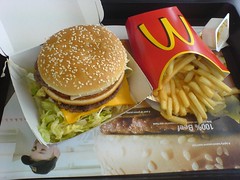A standard pricing strategy in many industries is bundling goods, e.g., productivity "suites" like Microsoft Office, value meals at fast food restaurants, hotel and flight combos, etc. In the labor market, we also see a kind of bundling, though not by design: each worker is a collection of skills and attributes that can't be broken apart and purchased separately by the firm. For example, by hiring me, my company gets my writing, meeting attendance, programming, etc.; they can't choose to not buy my low-quality expense-report-filing service.
Good mangers deal with this bundling by keeping workers engaged at their highest value activity. However, every activity has decreasing marginal returns, so even activities that start out as high-value eventually reach the "flat of the curve" where the marginal benefit of more of X gets pretty small. This phenomena gives large firms an advantage, in that their (generally) larger problems give workers more runway to ply their best skills (by the same token, small firms have to worry much more about "fit" within their existing team).
While pervasive, this flat-of-the curve dynamic and the resulting small-firm handicap is not a fundamental feature of organizations or labor markets--it springs from the binary nature of employment. It goes away or it least is diminished if a worker can instead being partly employed (i.e., freelance) at a number of firms, each paying the worker to do what they do best. To date, the stated value proposition of most freelancing sites has been that they allow for global wage arbitrage. Obviously that's important, but I suspect this "unbundling" efficiency gain will, in the long term, have a more profound effect on how firms organize and how labor markets function.


No comments:
Post a Comment